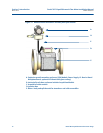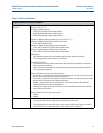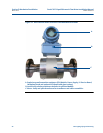
Daniel 3812 Liquid Ultrasonic Flow Meter Installation Manual Section 1: Introduction
3-9000-765 Rev D March 2013
Daniel 3812 Certifications and Approvals 19
1.9 Daniel 3812 Certifications and Approvals
Daniel 3810 Series Liquid Ultrasonic Flow Meters have electrical, metrology, intrinsic safety and
Pressure Equipment Directive certifications, approvals and lab testing and calibration
certifications by the agencies listed below. Refer to the nameplate tag on the meter body, the
wiring diagram (Drawing DMC - 0004936) in Appendix A and observe all safety precautions.
Daniel 3810 Series Liquid Ultrasonic Flow Meters operate within the pressure and temperature
rang
e of the device (also see Section 1.6 for meter specifications).
The Daniel 3810 Series Liquid Ultrasonic Flow Meters certifications and approvals are available
f
rom Daniel Measurement and Control, Inc.
• A
TEX (British Approval Service for Electrical Equipment in Flammable Atmospheres)
• I
ECEx (International Electrotechnical Commission for explosive atmospheres)
• U
.L. (Underwriter Laboratories)
• U.L
.C. (Underwriter Laboratories of Canada)
• PE
D (BSI Group) British Standards Institution
• INME
TRO (National Institute of Metrology, Quality and Technology)
• D
emko (Dansk Elektrisk Materiel Kontrol - Danish Electrical Equipment Supervision)
• G
OST R (Government Standard Russia)
• L.
A.B. (Laboratory Accreditation Bureau) ISO/IEC 17025:2005
1.10 FCC compliance
This equipment has been tested and found to comply with the limits for a Class A digital device,
pursuant to Part 15 of the FCC Rules. These limits are designed t
o provide reasonable protection
against harmful interference when the equipment is operated in a commercial environment.
This equipment generates, uses, and can radiate radio
frequency energy and, if not installed and
used in accordance with the instruction manual, may cause harmful interference to radio
communications. Operation of this equipment in a residential area is likely to cause harmful
in
terference in which case the user will be required to correct the interference at his own
expense.
Changes or modifications not expressly approved by the party responsible for compliance
could void the user's authority to operate the equipment.


















